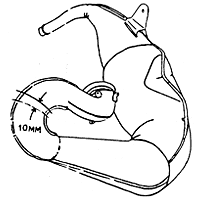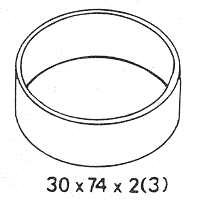
10mm is cut out
of the standard exhaust pipe. The cut
should be right at the
U-shaped section that bulges as the
header section leaves the cylinder. |

10mm is cut out
of the standard exhaust pipe. The cut
should be right at the
U-shaped section that bulges as the
header section leaves the cylinder. |
|
EXHAUST
PIPE
Next, a section of the header pipe on the
exhaust system must be cut out. Take a hacksaw
and slice out a 10mm section from the right
side of the pipe while it's on the bike.
The cut should be right at the U-shaped
section that bulges as the header section
leaves the cylinder. Tack weld the pipe
together, then remove it from the machine
and complete the weld. Again, use extreme
caution, and preferably, have an expert
do the welding.
AIR FILTER
If water, mud and extreme dust are not factors,
the stock air filter and intake system can
get trashed. The high breather system stifles
the air intake and hampers the power of
the Tri-Z.
This intricate design is replaced by a K&N
filter, #RC2000. If you look closely, it's
the same filter used on Harley choppers.
If you run this filter, the tool kit and
coolant reservoir get the ax. Also, a section
of the rear fender must be chopped away
to allow room for the K&N unit. Leave
the stock intake boot on the carb. An adapter
must be made to connect the new filter to
the carb boot. Check the photos to get the
idea; it should measure 30mm long with a
74mm O.D. and be 2mm to 3mm thick.
REEDS, CARB AND
MUFFLER
Take the stock reeds off and replace them
with Boyesen fiber reeds. Only a small carburetion
change is needed; change the main jet from
a 470 to a 490. Last on the list is the
silencer and spark arrester. Chuck the stock
model and pop on an Answer Products unit.
|